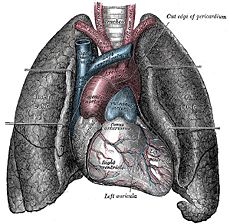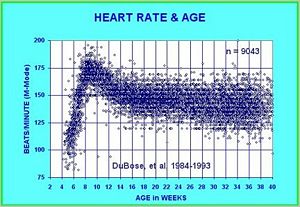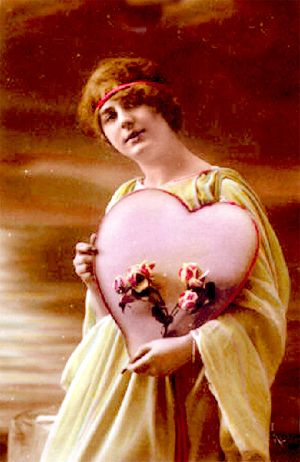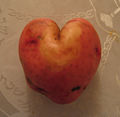Heart
In anatomy, the heart is the muscular, pumping organ of the closed circulatory system of all vertebrates and some invertebrates (annelids and cephalopods). It is responsible for moving blood through the blood vessels by automatic, repeated, rhythmic contractions, or a similar structure for moving blood (hemolymph) in the open circulatory system used by some invertebrates (arthropods and some mollusks).
The term "cardiac" (as in cardiology and cardiovascular system) means "related to the heart" and comes from the Greek κιĎδίι, kardia, for "heart" (AHSMD 2004). Cardiovascular disease refers to the class of diseases that involve the heart and/or blood vessels (arteries, and veins).
The average human heart beating at 72 beats per minute will beat approximately 2.5 billion times during a lifetime of 66 years.
In addition to the term heart being used in a physical sense, the term "heart" also is used in reference to the spiritual, emotional, and moral core of a human being. In the physical sense of the term, the heart is so integral to a person that the beat of the heart has represented life throughout history, for the lack of a heartbeat meant the end of life. Likewise, in a spiritual sense, the "heart" is considered integral to the very nature of human beings, being equated with the soul or spirit, and with the aspect of love. As the center of blood (physical life) and the non-physical organ of love (spiritual life), the heart reflects on the connection between life and love.
Overview
The heart is part of a living organism's circulatory system. The circulatory system, also referred to as a cardiovascular system, is an organ system that moves substances to and from cells; it can also play a part in homeostasis by helping stabilize body temperature and pH. An organ identified as a heart can be found in either an open or a closed circulatory system.
Open circulatory system. An open circulatory system is an arrangement of internal transport in which circulatory fluid, in a cavity called the hemocoel (also spelled haemocoel), bathes the organs directly. There is no distinction between blood and interstitial fluid; this combined fluid is called hemolymph (also spelled haemolymph). Hemolymph fills all of the interior hemocoel of the body and surrounds all cells. Muscular movements during locomotion by animals with such a system can facilitate hemolymph movement, but diverting flow from one area to another is limited. When the heart relaxes, blood is drawn back toward the heart through open-ended pores. The primary oxygen transporter molecule is hemocyanin. Open systems are present in some invertebrates, like mollusks and arthropods.
Closed circulatory system. The circulatory systems of all vertebrates, annelids (for example, earthworms), and cephalopods (squid and octopus) are closed, meaning that the blood never leaves the system of blood vessels, which consists of arteries, veins, and capillaries.
The main components of the closed circulatory system are the heart, the blood, and the blood vessels. Arteries bring oxygenated blood to the tissues (except pulmonary arteries), and veins bring deoxygenated blood back to the heart (except pulmonary veins). Blood passes from arteries to veins through capillaries, which are the thinnest and most numerous of the blood vessels.
The closed circulatory systems of fish, amphibians, reptiles, birds, and mammals show various stages of sophistication.
In fish, the system has only one circuit, with the blood being pumped through the capillaries of the gills and on to the capillaries of the body tissues. This is known as single circulation. The heart of fish is therefore only a single pump (consisting of two chambers).
In amphibians and most reptiles, a double circulatory system is used, but the heart is not always completely separated into two pumps. Amphibians have a three-chambered heart.
Birds and mammals show complete separation of the heart into two pumps, for a total of four heart chambers; it is thought that the four-chambered heart of birds evolved independently of that of mammals.
The heart in humans
Early development
The human embryonic heart begins beating around 21 days after conception, or five weeks after the mother's last normal menstrual period (LMP), which is the date normally used to date pregnancy. The human heart begins beating at a rate near the motherâs, about 75-80 beats per minute (BPM). The embryonic heart rate (EHR) then accelerates linearly for the first month of beating, peaking at 165-185 BPM during the early seventh week, (early ninth week after the LMP). This acceleration is approximately 3.3 BPM per day, or about 10 BPM every three days, an increase of 100 BPM in the first month (DuBose et al. 2000).
After peaking at about 9.2 weeks after the LMP, the human embryonic heart rate (EHR) decelerates to about 152 BPM (+/-25 BPM) during the fifteenth week after the LMP. After the fifteenth week, the deceleration slows reaching an average rate of about 145 (+/-25 BPM) BPM at term. The regression formula that describes this acceleration before the embryo reaches 25 millimeters in crown-rump length or 9.2 LMP weeks is embryonic age in days = EHR(0.3)+6 (DuBose n.d.). There is no difference in male and female heart rates before birth (Dubose n.d.).
It is unknown how blood in the embryo circulates for the first 21 days in the absence of a functioning heart, although some have hypothesized that the heart is not so much a pump, as a hydraulic ramâan organ built-up from cumulative peripheral activity (Marinelli et al. 1995).
Structure
In the human body, the heart is usually situated in the middle of the thorax with the largest part of the heart slightly offset to the left (although sometimes it is on the right), underneath the breastbone. The heart is usually felt to be on the left side because the left heart (left ventricle) is stronger (it pumps to all body parts). The left lung is smaller than the right lung because the heart occupies more of the left hemithorax.
The heart is enclosed by a sac known as the pericardium and is surrounded by the lungs. The pericardium comprises two parts: The fibrous pericardium, made of dense fibrous connective tissue, and a double membrane structure containing a serous fluid to reduce friction during heart contractions (the serous pericardium). The mediastinum, a subdivision of the thoracic cavity, is the name of the heart cavity.
The heart consists of four chambers, the two upper atria (singular: Atrium) and the two lower ventricles. The apex is the blunt point of the heart situated in an inferior (pointing down and left) direction. A stethoscope can be placed directly over the apex so that the beats can be counted. It is located posterior to the 5th intercostal space in the left mid-clavicular line. The heart is composed of cardiac muscle, an involuntary muscle tissue of the autonomic nervous system, which is found only within this organ (AHSMD 2004).
In normal adults, the mass of the heart is 250-350 grams (9-12 ounces), or about three quarters the size of a clenched fist, but extremely diseased hearts can be up to 1000 grams (2 pounds) in mass due to hypertrophy.
Functioning
The function of the right side of the heart is to collect de-oxygenated blood from the body into the heart's right atrium, and pump it via the right ventricle into the lungs (pulmonary circulation) so that carbon dioxide can be released and oxygen picked up (gas exchange). This happens in the lungs through the passive process of diffusion. The left side of the heart collects oxygenated blood from the lungs into the left atrium. From the left atrium, the blood moves to the left ventricle, which pumps it out to the body.
On both sides of the heart, the lower ventricles are thicker and stronger than the upper atria. The muscle wall surrounding the left ventricle is thicker than the wall surrounding the right ventricle due to the higher force needed to pump the blood through the systemic circulation.
More specifically, starting in the right atrium, the blood flows through the tricuspid valve to the right ventricle. Here it is pumped out the pulmonary semilunar valve and travels through the pulmonary artery to the lungs. From there, blood flows back through the pulmonary vein to the left atrium. It then travels through the bicuspid valve to the left ventricle, from where it is pumped through the aortic semilunar valve to the aorta. The aorta forks, and the blood is divided between major arteries that supply the upper and lower body. The blood travels in the arteries to the smaller arterioles, then finally to the tiny capillaries that feed each cell. The (relatively) deoxygenated blood then travels to the venules, which coalesce into veins, then to the inferior and superior venae cavae, and finally back to the right atrium where the process began.
The heart is effectively a syncytium, a meshwork of cardiac muscle cells interconnected by contiguous cytoplasmic bridges. This relates to electrical stimulation of one cell spreading to neighboring cells.
Aztec heart removal
The Aztec civilization used the heart as a sacrificial token during the sacrifice of a human being. The priest used a stone knife to cut into the thoracic cavity and remove the heart, upon which it would be placed on a stone altar as an offering to the gods. The greatest sacrifice under the reign of Montezuma involved the removal of the hearts of over 12,000 enemy soldiers.
Food use of animal hearts
The hearts of cattle, sheep, pigs, chickens, and certain other vertebrates are consumed in many countries. They are counted among offal, but being a muscle, the taste of heart is like regular meat. It resembles venison in structure and taste. Beef heart is the largest of those commonly consumed, followed by calves, lambs, and chickens (Herbst 2001). It is typically a rich source of protein, niacin, iron, and vitamins B1 and B2 (Bender and Bender 2005). Because the heart is almost entirely muscle it tends to be tough, but generally the younger the animal the more tender the heart (Herbst 2001).
"Heart" as a symbol or in a spiritual sense
The heart (âĽ) has long been used as a term referring to the spiritual, emotional, moral, and in the past also intellectual core of a human being. As the physical heart was once widely believed to be the seat of the human mind, the word heart continues to be used in a spiritual sense to refer to the soul or spirit, and stylized depictions of hearts are extremely prevalent symbols representing love.
However, more realistic depictions of human hearts tend to have macabre connotations of death and violence, quite unlike the concepts associated with the poetic and symbolic heart.
In mythology, spirituality and religion
In religious texts such as the Bible, the heart has historically been ascribed much mystical significance, either as metaphor or as an organ genuinely believed to have spiritual or divine attributes (Kohler et al. 2002).
In the Bible, this idea emerges in the earliest passages; Genesis 6:5 situates the thoughts of evil men in their hearts, and Exodus 5 through 12 speak repeatedly of the Lord "hardening Pharaoh's heart." By this, it is meant that God made Pharaoh resolve not to let the Israelite slaves leave Egypt, in order to bring judgment against Pharaoh and demonstrate his power: "Go to Pharaoh, for I have hardened his heart and the hearts of his officials so that I may perform these miraculous signs of mine among them" (Exodus 10:1). In the Book of Jeremiah 17:9, it is written that the "heart is deceitful above all things, and desperately wicked," and that the Lord is the judge who "tries" the human heart.
The Sacred Heart of Jesus and the Immaculate Heart of Mary are traditional Roman Catholic devotional images.
Similarly, in Egyptian mythology, the heart was weighed in a balance against the feather of Ma'at, symbolizing truth, in the judgment of the dead in the Egyptian Book of the Dead. Egyptian sources do not actually reveal whether the heart had to be lighter or heavier than the feather for the deceased to pass into paradiseâall depictions show only the weighing of the heart, not the actual results, heavier or lighter.
In early science and philosophy
Many classical and medieval philosophers and scientists, including Aristotle, considered the heart the seat of thought, reason, or emotion, often rejecting the value of the brain.
The Roman physician Galen located the seat of the passions in the liver, the seat of reason in the brain, and considered the heart to be the seat of the emotions. While Galen's identification of the heart with emotion were proposed as a part of his theory of the circulatory system, the heart has continued to be used as a symbolic source of the inner core of human emotions.
The Stoics taught that the heart was the seat of the human soul.
These aspects of the human heart are also reflected in the East. The Chinese character for "spiritual heart" appears to originate from a pictograph of a physical heart in body. The Chinese character for physical heart combines characters for the spiritual heart with characters indicating physical organs. The Chinese character, or Hanzi, for "love" also has the Chinese character for a heart right in the middle of it (GC 2006).
Today, the heart continues to be used as a term to represent the soul or spirit of a human being, that aspect that is the non-corporeal inner core of a person and that aspect that yearns to love and be loved.
Additional images
ReferencesISBN links support NWE through referral fees
- American HeritageÂŽ Stedman's Medical Dictionary (AHSMD) 2004. Heart. KMLE Medical Dictionary. Retrieved December 21, 2007.
- Bender, D.A., and A.E. Bender. 2005. A Dictionary of Food and Nutrition. New York: Oxford University Press. ISBN 0198609612
- Dietz, A. 2006. The heart symbol: Origin, history, and significance. HeartsSymbol.com. Retrieved December 21, 2007.
- DuBose, T.J., M.M. Miller, and D.M. Moutos. 2000. Embryonic heart rates compared in assisted and non-assisted pregnancies. Obgyn.net. Retrieved December 21, 2007.
- DuBose, T. J. n.d. http://www.obgyn.net/english/pubs/features/dubose/ehr-age.htm Sex, heart rate and age]. Obgyn.net. Retrieved December 21, 2007.
- Good Characters (GC). 2006. http://goodcharacters.com/chinese.symbol.for.love.html Chinese symbol for love]. GoodCharacters.com. Retrieved December 21, 2007.
- Herbst, S. T. 2001. The New Food Lover's Companion: Comprehensive Definitions of Nearly 6,000 Food, Drink, and Culinary Terms. Barron's Cooking Guide. Hauppauge, NY: Barron's Educational Series. ISBN 0764112589
- Kohler, K., T. Schanfarber, et al. 2002. Heart. JewishEncyclopedia.com. Retrieved December 21, 2007.
- Marinelli, R., B. Fuerst, H. van der Zee, A. McGinn, and W. Marinelli. 1995. The heart is not a pump: A refutation of the pressure propulsion premise of heart function. Frontier Perspectives 5(1). Retrieved December 21, 2007.
- McDonell, K. 2007. The shape of my heart: Where did the ubiquitous Valentine's symbol come from?. Slate February 13, 2007. Retrieved December 21, 2007.
External links
All links retrieved June 25, 2024.
| ||||||||||||||||||||
| Cardiovascular system - edit |
|---|
| Blood  | Heart â Aorta â Arteries â Arterioles â Capillaries â Venules â Veins â Vena cava â Heart â Pulmonary arteries â Lungs â Pulmonary veins â Heart |
Credits
New World Encyclopedia writers and editors rewrote and completed the Wikipedia article in accordance with New World Encyclopedia standards. This article abides by terms of the Creative Commons CC-by-sa 3.0 License (CC-by-sa), which may be used and disseminated with proper attribution. Credit is due under the terms of this license that can reference both the New World Encyclopedia contributors and the selfless volunteer contributors of the Wikimedia Foundation. To cite this article click here for a list of acceptable citing formats.The history of earlier contributions by wikipedians is accessible to researchers here:
The history of this article since it was imported to New World Encyclopedia:
Note: Some restrictions may apply to use of individual images which are separately licensed.






